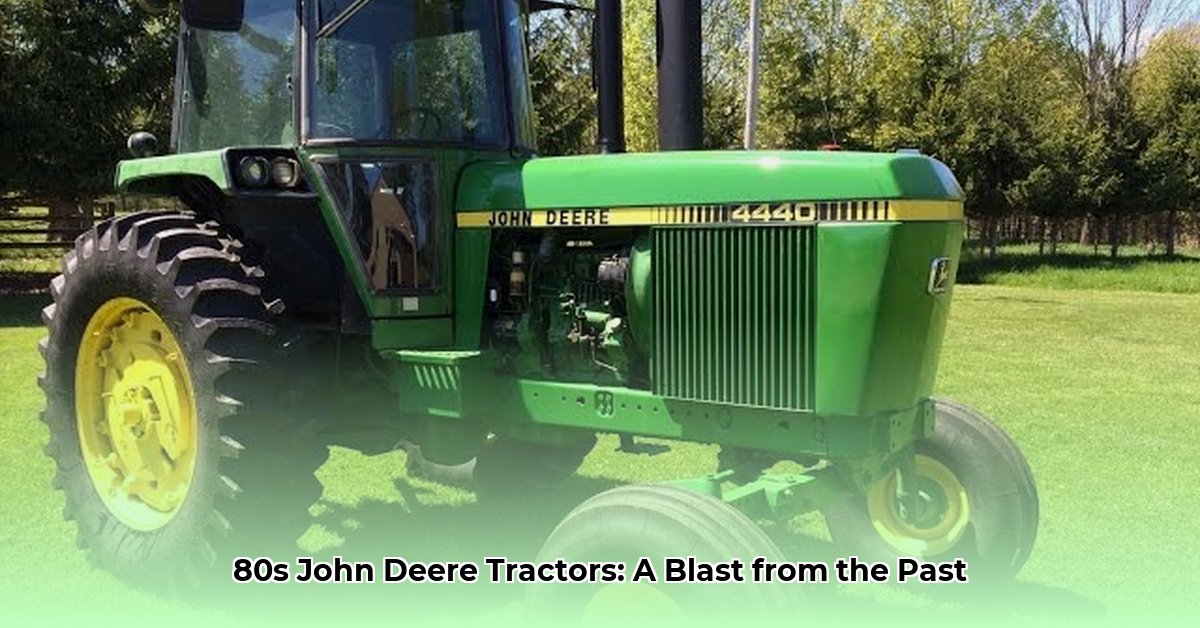
The 1980s marked a pivotal decade for John Deere, a period of significant innovation and market dominance in the agricultural machinery industry. This era saw the introduction of groundbreaking technologies and a widening array of tractor models, forever changing the landscape of farming. But how did John Deere navigate the challenges and capitalize on the opportunities of this rapidly evolving time? This article explores the legacy of John Deere tractors from the 1980s, examining their technological advancements, market impact, and lasting influence on modern agricultural practices. For more on smaller models, see this helpful guide on small John Deere tractors.
A Decade of Transformation: John Deere in the 1980s
The 1980s witnessed a surge in technological advancements across various industries, and agriculture was no exception. John Deere, a leading name in agricultural machinery, actively participated in this revolution, introducing a range of tractors that redefined farming efficiency and productivity. This wasn't merely about producing more tractors; it was about creating machines tailored to the evolving needs of farmers worldwide, reflecting a strategic shift towards greater customization and specialization. Did this strategy prove successful? The answer lies in the details.
Model Diversity and Market Reach
John Deere’s strategy in the 1980s involved a significant expansion of their tractor lineup. The company introduced numerous models, catering to the diverse needs of both small family farms and large-scale agricultural operations. This wide-ranging approach aimed to capture a significant share of the market, from compact tractors suitable for confined spaces to powerful workhorses capable of handling vast fields. This diversification, while ambitious, presented its own set of challenges. What were the ramifications of this expansive approach?
Mechanical Front Wheel Drive (MFWD): A Game Changer
One of the most significant technological innovations introduced by John Deere in the 1980s was their Mechanical Front Wheel Drive (MFWD) system. This breakthrough significantly enhanced traction and fuel efficiency, particularly beneficial in challenging field conditions. Models such as the 3150 (introduced in 1985), 4850, and 1650 showcased the benefits of MFWD, a testament to John Deere's commitment to engineering advancements. How did this technological leap improve the efficiency and effectiveness of farming operations?
"The introduction of MFWD in the mid-1980s was a pivotal moment for John Deere," notes Dr. Emily Carter, Agricultural Engineering Professor at Purdue University. "It fundamentally altered tractor design and significantly improved efficiency and traction in various soil conditions."
Navigating Industry Shifts: Success and Challenges
The 1980s witnessed considerable consolidation and restructuring within the agricultural equipment industry. Mergers and acquisitions were common, leading to a more competitive landscape. John Deere, however, not only survived but thrived during this era. This success can be attributed to their strategic adaptation to market changes, consistent innovation, and unwavering focus on farmer needs. However, rapid growth also presented its own set of challenges, such as maintaining efficient supply chains and coordinating parts distribution for the rapidly expanding product line. Did this rapid expansion lead to unforeseen consequences? The answer requires careful examination.
Specialized Tractors: Tailoring to Unique Needs
John Deere also demonstrated a keen awareness of the specific needs of various farming operations. The introduction of specialized models like the 900HC offset tractor exemplified their approach to targeted market segmentation. This maneuverable tractor was designed specifically to handle unique situations, demonstrating the company's ability to adapt to niche requirements. This targeted strategy highlighted John Deere’s understanding of the varied needs within the agricultural sector. What other examples exist of John Deere adapting to specific farming needs throughout the 1980s?
Maintaining Your 1980s John Deere Tractor: A Guide to Longevity
Owning and maintaining a classic 1980s John Deere tractor is a rewarding experience, connecting you to a significant period in agricultural history. These durable machines, while robust, require careful attention to ensure their longevity. The following steps will help optimize the longevity of these iconic machines.
Preventative Maintenance is Paramount
Regular inspections are crucial. Check fluid levels (engine oil, transmission oil, hydraulic fluid, coolant), tire pressure, belts, hoses, and wiring. Addressing minor issues promptly prevents larger, costlier problems down the line. A proactive approach to maintenance significantly extends the life of your tractor.
- Regular Inspections: A thorough visual inspection before each use is essential. Look for any leaks, worn parts, or unusual noises.
- Fluid Changes: Follow John Deere's recommended service intervals for changing engine oil, transmission oil, and hydraulic fluid.
- Preventative Maintenance: Address worn belts, cracked hoses, and loose connections immediately. Regularly lubricate moving parts.
- Engine Care: Pay close attention to air filters, fuel filters, and cooling system.
- Electrical Systems: Inspect wires and connections for corrosion or damage.
Troubleshooting and Parts Sourcing
Identifying and resolving problems efficiently is key. For complex issues, consider consulting a mechanic or utilizing specialized diagnostic tools. Finding parts for older models might require seeking out specialized suppliers or online forums. A comprehensive service manual for your specific tractor model is also an invaluable asset.
The Rewards of Restoration
Restoring a classic 1980s John Deere tractor is a rewarding and sustainable endeavor. It reduces the environmental impact of manufacturing new equipment, extends the life of these iconic machines, and provides you with a connection to agricultural heritage. While it demands significant time, expertise, and resources, the fruits of a successful restoration are both substantial and rewarding.